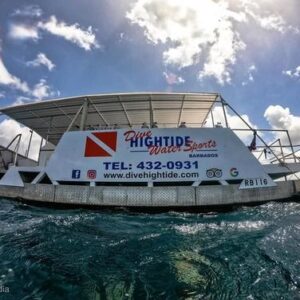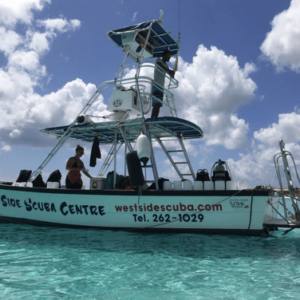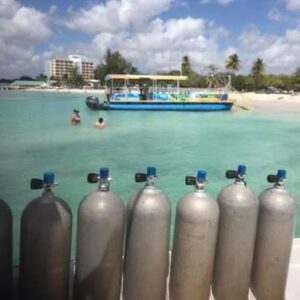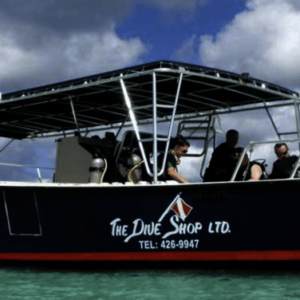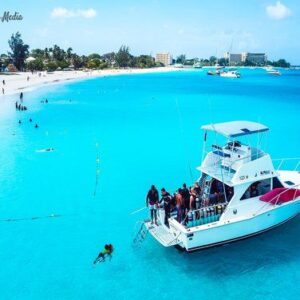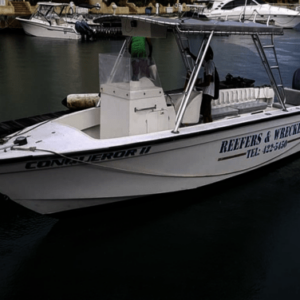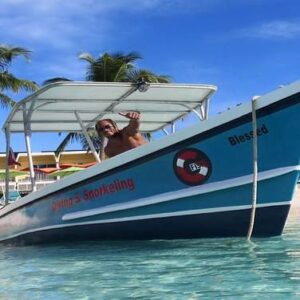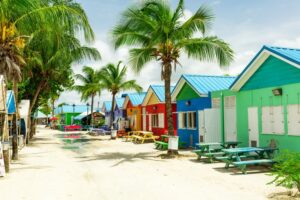 Barbados is a scuba divers dream and on every scuba bucket list! It is the eastern most island in the Lesser Antilles. It is surrounded by the Caribbean Sea on its west coast and the Atlantic Ocean on the east. The island is shaped like a foot with a length of about 21 miles and width of 14 miles. It was created by coral rising from the ocean depths and as a result the island is surrounded by fringing. The reef consists of a variety of corals including Staghorn, Gorgonian, Finger, Brain, Fire and more. Barbados has caused hundreds of ships to sink due to its eastern location and shallow reefs. Both reefs and wrecks are covered with huge barrel sponges and colorful sea fans. Divers will experience sightings of various and unique marine life including seahorses, conch shell, rays, eels, and starfish. A variety of fish live in the tropical waters of Barbados. Divers can encounter Triggerfish, Parrotfish, Angelfish, Trunkfish, Damselfish, Trumpetfish, Filefish, and Grunts as well as Barracuda, Jacks, Chub, Frog Fish, Grouper, Snapper, Mackerel, Lionfish, and sharks. Barbados is also home to Hawksbill, Green and Leatherback turtles.
Barbados is a scuba divers dream and on every scuba bucket list! It is the eastern most island in the Lesser Antilles. It is surrounded by the Caribbean Sea on its west coast and the Atlantic Ocean on the east. The island is shaped like a foot with a length of about 21 miles and width of 14 miles. It was created by coral rising from the ocean depths and as a result the island is surrounded by fringing. The reef consists of a variety of corals including Staghorn, Gorgonian, Finger, Brain, Fire and more. Barbados has caused hundreds of ships to sink due to its eastern location and shallow reefs. Both reefs and wrecks are covered with huge barrel sponges and colorful sea fans. Divers will experience sightings of various and unique marine life including seahorses, conch shell, rays, eels, and starfish. A variety of fish live in the tropical waters of Barbados. Divers can encounter Triggerfish, Parrotfish, Angelfish, Trunkfish, Damselfish, Trumpetfish, Filefish, and Grunts as well as Barracuda, Jacks, Chub, Frog Fish, Grouper, Snapper, Mackerel, Lionfish, and sharks. Barbados is also home to Hawksbill, Green and Leatherback turtles.
Year-round temperatures averaging 85 degrees F, the island’s location outside the hurricane belt, and the distinctive and different dive sites, makes Barbados the ultimate scuba destination for beginners to advanced divers. Barbados has it all!
GETTING THERE
Barbados is just over 4-hours flying time from Florida and requires a valid passport.
GETTING AROUND
The public transportation in Barbados is user friendly but does require exact change. The Barbados Transport Board buses are easy to spot. They’re painted in the national colors of blue with a yellow stripe. Barbados has forty-nine air conditioned, and Wi-Fi connected buses crisscrossing the island.
If plans take you off the beaten path, taxis are the way to travel. Taxis are the most expensive travel option, but fares are controlled by the government by length of travel.
If needing to travel in a hurry, minibuses are smaller private buses that take the same route as the government buses and are painted in the inverse color scheme-yellow with a blue stripe. While not for the faint at heart, these are a convenient alternative for hurried travel plans.
GOOD TO KNOW
Country: Barbados is an independent British Commonwealth nation.
Time Zone: Atlantic Standard Time
Primary Language: English
Currency: Barbados Dollar (BBD)
Cell Phone Service: US cell phone with roaming
Voltage: 115V with the same plug as the US.
Hurricane Details: Located outside of the hurricane belt.
DIVE CONDITIONS
Water Temperature: 70-80 degrees F year-round.
Water Visibility: Excellent water visibility up to eighty feet.
When to Go: Any time of the year.
Diving Difficulty: Beginner – Advanced
TOP DIVE SITES IN BARBADOS
Barbados caters to the wreck diving enthusiast! Most diving happens on the sheltered western side, but advanced divers head to the east for a unique experience, body of water and some open-ocean thrill. Barbados dive sites listed below note (B) for beginner divers and (A) for the advanced diver.
- The Boot dive (B) site is located just off the famous Sandy Beach on Barbados’ west coast and combines the best of both wrecks and reefs. A small Coast Guard ship sank here and is covered with sponges and corals. The vivid reef is coated with a vibrant coral cover. The Boot is a good site for all divers due to its sheltered location and depths between 40-80 feet. Divers have an excellent chance to come across turtles, rays, trumpet fish and peacock flounders.
- Carlisle Bay (B) is positioned in a marine park on the island’s south-west coast and home to six sunken wrecks. The sheltered bay offers the ideal place for beginner divers to enjoy and practice wreck diving. The most popular wrecks to explore here are the Bajan Queen and The Berwyn. The Bajan Queen was Barbados’s first tugboat which was later converted to a party boat. Barbadians hold fond memories of this tug. It was donated to the Coastal Zone Management Unit where it was cleaned up and sank in 2002. The Berwyn is a 70 foot WWI French tugboat sank by its own crew in 1919 and lays just seven to ten feet under the water. Both wrecks are covered in marine life and divers can expect to see frogfish, sea horse, rays, barracuda, octopus, reef squid, mackerel, and moray eel.
- Cement Plant Pier (B) is located on the north coast. This abandoned cement factory provides homes to a wide variety of marine life. As one the most popular dives in Barbados, it is accessible by shore or boat and often very crowded. The key to this dive is finding a dive time when it is less populated. The pier remains have outstanding coral cover coating the columns which provides homes to tropical fish, including the elusive frogfish. Divers can expect to encounter crabs, scorpionfish, gurnard, lobster, and long-snout seahorses.
- SS Stavronikita (B)is considered by many as the best wreck site in Barbados. Located on the west coast, the Greek freighter caught fire and sunk in the early 70’s killing six crew members and injuring three others. The depth variations of this wreck make it suitable for divers of all levels. After 30 years under the sea, the wreckage is an established artificial reef and is covered with coral. Divers can expect to see a rainbow of huge tube and rope sponges including large gorgonian fans, as well as barracuda, and turtles.
- Barracuda Junction (A) is known for the large schools of barracuda that stalk this area in search of a meal. Most dives here are drift dives but with the slope of the reef at depths of up to 150 feet, scuba diving is also popular. This reef provides a home to numerous fish and sponges. Divers can encounter not only colorful sponges but large schools of barracuda and baitfish.
- Pamir (B) is located on the west coast and considered a well-preserved wreck 160 feet long and sixty feet deep. Purposely sunk in 1983, this dive offers a relaxing dive for both the beginner and advanced diver. An abundance of marine life makes their home on Pamir which makes it an exceptional dive.
- Consett Bay (A) on the Atlantic east coast is a great dive for those wanting a chance to see sharks. There are ten dive sites on the Atlantic side of Barbados. The summer months offer divers calmer waters, but the water is rough. With huge coral formations, caverns, and swim-throughs, Consett Bay attracts advanced divers. Large pelagic animals such as jacks and king trevally have been spotted around this reef site.
- Maycocks Bay (A) is a unique site with barrel sponges, large blocks of corals and white sandy channels to follow and explore. Divers will see parrotfish, schools of Bermuda chub and lobsters as well as schools of barracudas.
- Highwire (A) is an unusual site with underwater cables that are suspended over the reef. Located in rough waters, this dive is reserved for advanced divers. With depths of 60-120 feet, the reef is full of sponges and corals that hide many unique creatures including shrimp and nudibranchs. This site is a photographer’s dream!
- The Muff (A) is famous for the bright orange elephant ear sponges. The reef is covered in barrel sponges, large sea fans, coral whips and plumes. This reef drops down sharply to over 130 feet on one side and gentle slopes reaching depths of 100 feet on the other. Encounters include barracuda along with horse-eye jacks, blackjacks, and the occasional shark.
- The Johnsons (B) is a popular west coast dive in Barbados due to the abundance of marine life. The soft corals and the huge tube and barrel sponges are perfect homes for small reef creatures. Large schools of parrotfish, turtles and barracuda frequent this reef. With depths of 70-80 feet and its consistent conditions, this spot is perfect for photographers.
- Dottins (B) is a shallow reef dive (40-60 feet) on the west coast of Barbados. Creole wrasse covers the reef which can be easily seen when light filters through the water. Divers can spot large turtles, groupers, yellowtail snapper, runts, and stingrays. This is a great place to find conch shells often hidden in the sandy patches.
- The Great Ledge (A) is carpeted in a wide variety of coral and plant life which is home to a multitude of marine life. This shallow ledge reef stretches from 55-80 feet. Atlantic spade fish, mackerel, lizardfish and scrawled filefish are just a few creatures that divers can expect to see.
- Old Fort (B) is an ideal shallow barrier reef for beginners at 30-90 feet in depth. This historic fort includes a collection of cannonballs and antique bottles. Small groups of sponges and coral boulders litter the sandy floor. Some of the fish found at the Fort are sea anemones, cleaner shrimp, glassy eyes, grunts, yellow goatfish and spotted drums. This is a great drift dive location and a photographer’s dream.
- Bright Ledge (A) is home to one of the most vibrant reefs among all of Barbados’ dive sites with depths of 50 feet and dropping more than 200 feet. The reef is alive with colorful corals, sponges, shellfish such as lobsters and crabs and attracts barracudas, nurse sharks, and manta rays who come to feed. Divers also can see the endangered Hawksbill turtle which is known to frequent this area.
- Clarke’s Bank (A) is a beautiful and vibrant reef containing both hard and soft corals. At 60-90 feet, divers can see large, red gorgonian sea fans which lure many photographers. The locally based Atlantis Submarine often circles the reef and the divers. Horse-eye jacks, creole wrasse and yellowtail snapper are some of the highlights of Clarke’s Bank.
- Caribbee (A) is a dome-shaped barrier reef heading in a westerly direction and is a drift divers paradise. Beginning at 60 feet and dropping off on either side to 150 feet, divers can enjoy an abundance of purple sea fans and red gorgonian. Barracuda, eagle rays and turtles frequent this area as well as a huge variety of reef fish.
- Bell Buoy (B) received its name for its bell-shaped reef. Located 30-70 feet below the surface, this reef offers something unique for all diving levels. The massive reef is covered with a forest of beautiful brown corals that host a variety of creatures. Bell Buoy is a reef with different coral environments and marine life including gorgonian corals, angelfish, and parrotfish. Bell Buoy is an educational and exhilarating dive!
For a memorable scuba diving experience, Barbados is the perfect destination. With an incredible assortment of underwater species, vast coastline and ideal weather conditions, Barbados is one of the world’s leading diving destinations that scuba divers return to year after year.

